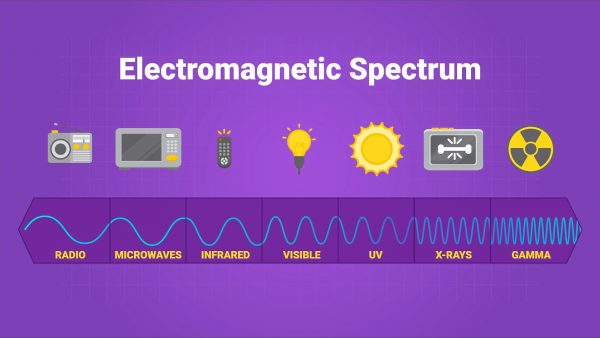Electromagnetic Spectrum Definition
The electromagnetic spectrum ranges from low-energy radio waves to high-energy gamma rays, including visible light and X-rays. The main pattern observed in the electromagnetic spectrum is that waves with shorter wavelengths and higher frequencies have higher energy.
View Lesson on Electromagnetic Spectrum
Become a member to get full access to our entire library of learning videos, reading material, quiz games, simple DIY activities & more.
Become a member to get full access to our entire library of learning videos, quiz games, & more.
Plans & Pricingto watch this full video.

Access All Videos
and Lessons, No Limits.
Access All Videos

No credit card required,
takes 7 sec to signup.
No card required

Ready-to-go lessons
that save you time.
Ready-to-go lessons
If you are on a school computer or network, ask your tech person to whitelist these URLs:
*.wistia.com, fast.wistia.com, fast.wistia.net, embedwistia-a.akamaihd.net
Sometimes a simple refresh solves this issue. If you need further help, contact us.
Electromagnetic Spectrum
Fun Facts
- Astronomers rely on the electromagnetic spectrum to detect and visualize objects and events in space.
- Laser light can range from infrared to visible to ultraviolet on the electromagnetic spectrum.
- Radio waves, visible light, and x-rays are not different kinds of radiation but rather all parts of a continuous electromagnetic spectrum.
Why Do We Need To Know About Electromagnetic Spectrum
Studying the electromagnetic spectrum helps us see how the world works and how technology and nature are linked. Things like seeing, talking, and cooking are all affected by electromagnetic waves, which include radio waves and X-rays. Different parts of the spectrum can be used for encoding signals over WiFi networks and treating cancerous tumors.
Knowing about this not only makes us understand daily life better but also shows us many job options. People like doctors who work with X-rays, scientists who study stars, and firefighters use electromagnetic waves in their jobs.
Frequently Asked Questions
Check out the Full Lesson on Electromagnetic Spectrum
In this lesson, we learn that:
- Electromagnetic radiation is a type of wave that transfers energy.
- It includes radio waves, microwaves, infrared waves, visible light, UV light, X-rays, and gamma rays.
- The difference between all of these is the wavelength of the radiation.
Related Topics
- Air Mass Definition
- Algae Definition
- Astronomy Definition
- Balanced Force Definition
- Cellular Respiration Definition
- Chemistry Definition
- Chloroplast Definition
- Climate Definition
- Definition Of Engineering
- Digestive System Definition
- Distillation Definition
- Divergent Boundary Definition
- Ecosystem Definition
- Electromagnet Definition
- Electromagnetic Radiation Definition
- Electromagnetic Spectrum Definition
- Energy Transfer Definition
- Extinct Definition
- Fossil Record Definition
- Frequency Definition
- Geologic Processes Definition
- Gravity Definition
- Heat Definition
- Insulator Definition
- Keystone Species Definition
- Kinetic Energy Definition
- Light Definition
- Light Reflection Definition
- Magnetic Poles Definition
- Material Definition
- Nervous System Definition
- Orbit Definition
- Plant Growth Definition
- Reactants Definition
- Recycle Definition
- Reproduction Definition
- Salt Water Definition
- Scientific Name Definition
- Sedimentary Rock Definition
- Snow Definition
- Soil Definition
- Solar Eclipse Definition
- States Of Matter Definition
- Symbiosis Definition
- Taxonomy Definition
- Transverse Wave Definition
- Tsunami Definition
- Wind Erosion Definition
Start a Free Trial Today. Get a $5 Amazon Gift Card!
Teachers! Start a free trial & we'll send your gift card within 1 day. Only cards left. Try it now.
Select Grade
Select Subject
This email is associated with a Science Kit subscription. Kit subscriptions are managed on this separate page: Manage Subscription

-
Download InvoiceScience & Math$/yr
-
Download InvoiceScience Only$/yr

access all lessons
• No credit card required •
"My students loved the videos. I started the video subscription in May and used them as a review before the state test, which I know contributed to 100% of my class passing the state test."
Rhonda Fox 4th Grade Teacher, Ocala, Florida
• No credit card required •
"My students loved the videos. I started the video subscription in May and used them as a review before the state test, which I know contributed to 100% of my class passing the state test."
Rhonda Fox 4th Grade Teacher, Ocala, Florida
• No credit card required •
Already a member? Sign In
* no credit card required *

* no credit card required *
* no credit card required *


no credit card required
Skip, I will use a 3 day free trial
Enjoy your free 30 days trial
-
Unlimited access to our full library
of videos & lessons for grades K-5. -
You won’t be billed unless you keep your
account open past your 14-day free trial. -
You can cancel anytime in 1 click on the
manage account page or by emailing us.
-
Unlimited access to our full library of videos & lessons for grades K-5.
-
You won't be billed unless you keep your account open past 14 days.
-
You can cancel anytime in 1-click on the manage account page.
Cancel anytime in 1-click on the manage account page before the trial ends and you won't be charged.
Otherwise you will pay just $10 CAD/month for the service as long as your account is open.
Cancel anytime on the manage account page in 1-click and you won't be charged.
Otherwise you will pay $10 CAD/month for the service as long as your account is open.
We just sent you a confirmation email. Enjoy!
DoneWe use cookies to make your experience with this site better. By using this site you agree to our use of cookies. Click "Decline" to delete and block any non-essential cookies for this site on this specific property, device, and browser. Please read our privacy policy for more information on the cookies we use.Learn More
We use cookies to improve your experience. By using this site, you agree to our use of cookies. Click "Decline" to block non-essential cookies. See our privacy policy for details.Learn More



























































































































